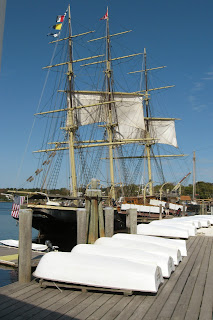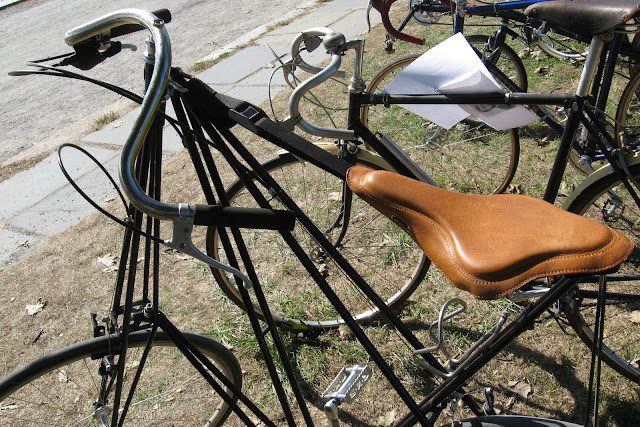Yesterday a went to the bike show at Mystic Seaport. It was a small show with only about 5-6 vendors, a bit of a disappointment considering the price of general admission to the Seaport. In terms of value, it was too expensive if you only wanted to look at bikes. If you have never been to the Mystic Seaport and you like bikes as well as early American history, ships and a beautiful setting, then it was worth it, monetarily speaking. Let me apologize in advance for the lack of specifics about each bike, I forgot to bring a notepad so details are to the best of my recall. Also it was sometimes difficult to photograph the bikes because they were often displayed in less than optimal conditions. No studio quality pics here.
Both of these bicycles featured wooden rims, their age and make is unknown.
Here is a closer look at the wooden handle bars. The saddle on the other bike in the background had Birmingham engraved in the leather, note the small cut out that was later used by Brooks in the late 1800's.
Not much leather left on the saddle. Note the seat stays are fastened to the frame via the seat post clamp, I saw this design on other bikes from the late 1800's. Although the pneumatic tire was invented in 1888 by John Dunlap, I seriously doubt the tires on these bikes are original due to the tread pattern and lack of dry rot.
A 90's Japanese track bike, Nagasawa fixie. I love the pealized color. The seat is fondly referred to as a hatchet.
This is a training stem which allows easy adjustment for various riders.
 |
sweet lug detail
|
This late 1800's Columbia single speed tandem was one of my favorites. It features a loop frame in the front and diamond in the rear. Presumably a woman was supposed to ride in the front and a man in the back. Some other particulars to note are the wooden rims, and the crank design which made it easier for
the woman to pedal while the man pushed a higher gear.
Here again is the same integrated seat post bolt and seat stays.
The rod brake up front is the only brake for the entire bike! The design is about as simple as it gets. If you look closely you will note a curved metal bar attached to the left side of the fork running down to the the second head tube just beyond the cranks. This allows the steering to be controlled by both riders.
This bike was made by Westfield Manufacturing (Columbia) in the late 1800's. It had a rear suspension and the same integrated seat post bolt - seat stay attachment as seen in some of the previous bikes.
The T seat post seams to have been a common design for this era.
 |
| Westfield Manufacturing headbadge |
I don't know what the syracuse on the headbadge is all about. If anyone has any ideas I would love to here them.
 |
| Circa 1930's Western Flyer (single speed, balloon tires) |
 |
Circa 1930 AFC tricycle (refurbished)
The Pedersen bicycle was designed by Mikael Pedersen circa 1984 after a suspension bridge. This bicycle was made by Copenhagen Pedersen who began reproducing the Pedersen in 1978 with modern components.
The saddle is one of the most out standing features of the Pedersen. As can be seen in the photo above it is suspended by a strap like a hammock and indeed like a hammock there isn't anything beneath the saddle in terms of support. Unfortunately for me the bike was too large for me to ride, but the vendor held the bike so I could sit on the saddle. It was like sitting on a sling with the leather sides bending to sides of my inner thighs. The ride was described to me as being light and providing a feeling of floating. I really would of liked to have ridden it to see for myself. To see and read more history and pictures about the Pedersen click here.

Picture of a Copenhagen Pedersen in action.
The weather was perfect and I enjoyed talking with the various vendors. Below are couple of non-bike related pics I snapped of the Seaport.
|























No comments:
Post a Comment